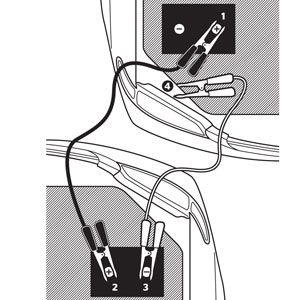 |
Description
100% copper core cable with PVC handle grip
Suitable for 12V and 24V cars and light commercial vehicles
Fitted with heavy duty fully insulated clips
Excellent and high quality control
Specification
Clamp Material: Copper plated
Colour: Red & Black
Insulator: PVC Jacket
Current: 500AMPS
Cable: 21mm2
Diameter:10.5mm,
Length:3metrs
Conductor Material: Copper
Copper Core Size: 6-8GA
|
|
How to Use
> Check your owner's manual before jump-starting your car or using it to jump-start another car. Some new cars had specific instructions or prohibit jump-starting.
> If it is OK to jump-start, attach the jumper cables correctly.
- Clamp one cable to the positive (+) terminal of the dead battery. Don't let the positive cable touch anything metal other than the battery terminals.
- Connect the other end of the positive cable to the positive terminal of the good battery.
- Connect one end of the negative (-) cable to the negative terminal of the good battery.
- Connect the other end of the negative cable to metal on the engine block on the car with the dead battery. Don't connect it to the dead battery, carburettor, fuel lines or moving parts.
- Stand back and start the car with the good battery.
- Start the stalled car.
- Remove the cables in reverse order.

How to Jump-Start a Diesel-Powered Automobile
Even though diesel-powered vehicles can have dual batteries or one oversized battery, it’s possible to jump-start a diesel from the battery on a conventional gasoline-powered vehicle. If your diesel won’t start due to a dead battery, follow the steps here to jump it safely.
To avoid confusion, these instructions call the vehicle with the dead battery the disabled vehicle and the one you’re jumping the start from the source vehicle. Follow these steps to jump-start a dead diesel battery:
Make sure that both vehicles are in Park or Neutral with the parking brakes on.
> Turn on the heater on the disabled diesel vehicle.
This protects the electrical system from surges in voltage.
> Make sure that the lights and other electrical accessories on the disabled diesel vehicle are off.
A vehicle with dual batteries usually has thicker cables on one of the batteries. Attach the jumper cables to the battery that has thicker cables. If either vehicle has dual batteries with cables of the same thickness, use either battery for the jump. If a vehicle has only one battery, just be sure to hook the cables up in the proper order.
> Connect the clamp on one of the jumper cables to the positive terminal of the disabled vehicle’s battery.
The positive terminal should have a (+) or a red cover on it.
> Connect the other end of the same jumper cable to the positive terminal of the source vehicle.
> Connect one end of the other jumper cable to the negative terminal (-) of the source vehicle.
> Connect the other end of that jumper cable to an unpainted, metallic part of the disabled vehicle.
Use the bracket that keeps the hood up, but any such part will do as long as it’s not near the battery, belts, or any other moving parts of the engine.
> Start the engine on the source vehicle.
> Start the engine on the disabled vehicle.
Let both engines run for a minute or two, more if the battery has been dead for a long time.
> Turn off the engine of the source vehicle.
Leave the disabled vehicle’s engine running.
> Remove the cable from the unpainted metal part of the disabled vehicle.
> Disconnect the cable from the positive terminals of both vehicles.
> Disconnect the cable from the negative terminal of the source vehicle.
> Drive the disabled vehicle around for at least 15 minutes to ensure that the battery is fully charged.
If you justify you have a dead diesel vehicle and the battery dies the next time you try to start the car, you probably need a new battery. Be sure to get the proper one for your vehicle’s make, model, and year. |
|
